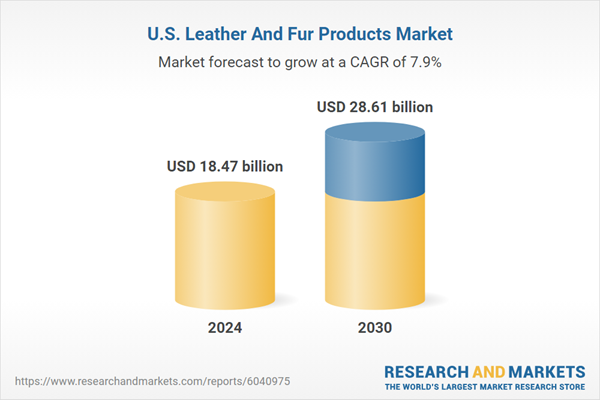U.S. Leather And Fur Products Market Growth & Trends
The U.S. leather and fur products market size is estimated to rise to USD 28.61 billion by 2030, progressing at a CAGR of 7.9% from 2025 to 2030. Proactive marketing initiatives by established brands in the country coupled with changing fashion trends are expected to boost market growth over the forecast period.Leather and fur are used for manufacturing a myriad of different products including women’s handbags, traveler bags, personal goods, and apparels, among others. Recent comeback of fur and leather products in popular fashion in urban areas has been a prime factor for steady rise in the demand. In addition, leather and fur product manufacturers have been focusing on providing enhanced shopping experiences and holding marketing campaigns, which is likely to further bolster the growth of the market.
However, the market faces two major challenges in its long-term sustainability, which includes consumer and environmental backlash for the use of animal-derived products and internal competition from products made from artificial leather and faux fur. To address these challenges, major vendors in the market are focusing on partnerships with their contemporaries. Consumer purchasing preferences are anticipated to largely influence the dynamics of the market.
The leather and fur products market in the U.S. is marked by presence of numerous well-known and established brands. While many of these players are large multinational companies, some vendors provide niche products, which has resulted in a highly fragmented marketplace.
U.S. Leather And Fur Products Market Report Highlights
- Onset of online shopping portals has had a large impact on product marketing, sales, and delivery of leather and fur products. However, brick and mortar stores continue to be the most preferred distribution channel for the products
- The leather and fur products market includes a complex and globalized value chain wherein materials and finished products are often traded across national boundaries
- As of 2015, the types of leathers used worldwide included 34% of sheep, 30% of goat, 23% of cattle, and 13% of pig per animal hide. This, in terms of skin surface, translates to 59% cattle, 20% sheep, 24% goat, and 17% pig
- Introduction of numerous new products that are manufactured with leather and fur accessories such as eyeglass cases, jewelry cases, and personal electronics cases are expected to augment the personal goods market
Why should you buy this report?
- Comprehensive Market Analysis: Gain detailed insights into the global market across major regions and segments.
- Competitive Landscape: Explore the market presence of key players worldwide.
- Future Trends: Discover the pivotal trends and drivers shaping the future of the global market.
- Actionable Recommendations: Utilize insights to uncover new revenue streams and guide strategic business decisions.
This report addresses:
- Market intelligence to enable effective decision-making
- Market estimates and forecasts from 2018 to 2030
- Growth opportunities and trend analyses
- Segment and regional revenue forecasts for market assessment
- Competition strategy and market share analysis
- Product innovation listing for you to stay ahead of the curve
- COVID-19's impact and how to sustain in these fast-evolving markets
This product will be delivered within 1-3 business days.
Table of Contents
Chapter 1. Methodology and Scope
Chapter 2. Executive Summary
Chapter 3. U.S. Leather and Fur Products Market Variables, Trends & Scope
Chapter 4. Consumer Behavior Analysis
Chapter 5. U.S. Leather and Fur Products Market: Product Estimates & Trend Analysis
Chapter 6. U.S. Leather and Fur Products Market: Competitive Analysis
List of Tables
List of Figures
Companies Mentioned
- COACH
- LVMH
- Kering
- Samsonite IP Holdings S.à r.l.
- VF Corporation
- RIMOWA
Methodology

LOADING...
Table Information
| Report Attribute | Details |
|---|---|
| No. of Pages | 60 |
| Published | December 2024 |
| Forecast Period | 2024 - 2030 |
| Estimated Market Value ( USD | $ 18.47 billion |
| Forecasted Market Value ( USD | $ 28.61 billion |
| Compound Annual Growth Rate | 7.9% |
| Regions Covered | United States |
| No. of Companies Mentioned | 6 |









